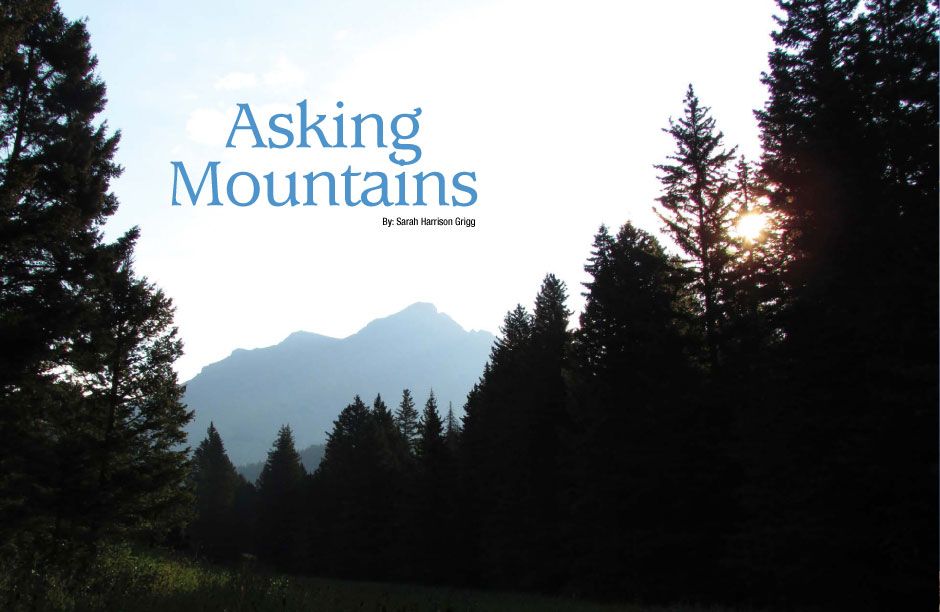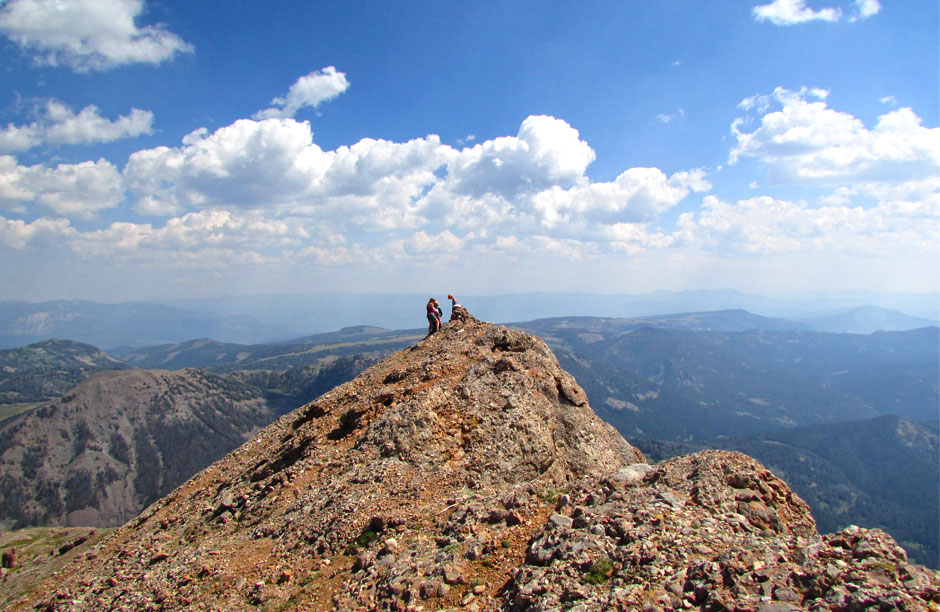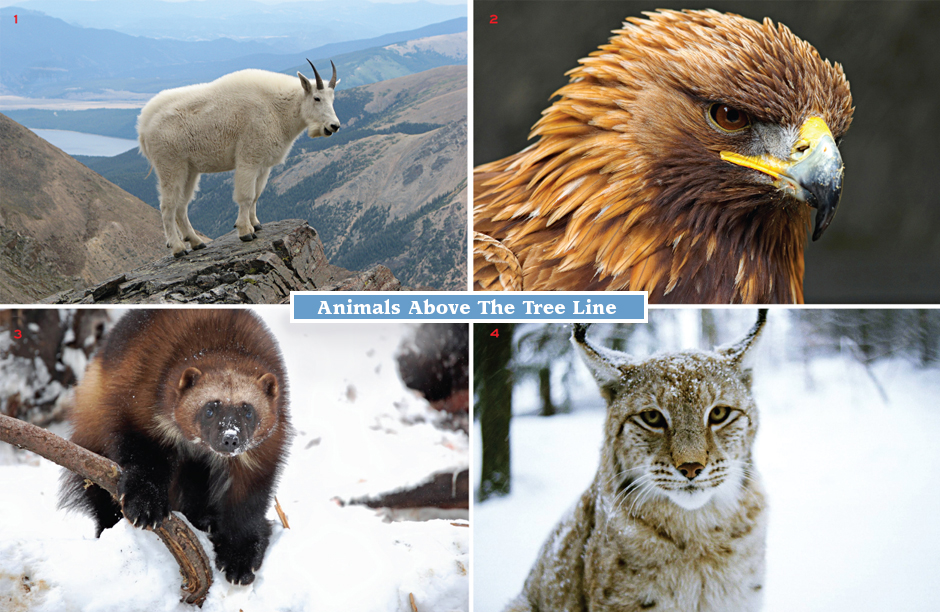Asking Mountains
By Sarah Harrison Grigg
Sphinx Mountain rises in southwest Montana’s Madison Range with two long ridges reaching out, guarding a singular deep avalanche chute. I drive by it often and think to myself, “I’d like to stand atop that one.”
Perhaps I’m drawn to the Sphinx because it is high and impressive, or because it stands apart from the rest of the range. Or perhaps I hope it is an oracle, like other sphinxes named in history who offer the challenge to crack their riddle and rise above other seekers. Isn’t that what we ask of oracles and of mountains — to make us wise, to let us in the know for the mere act of approaching them?
On a late day in August, I find myself finally setting off to reach its summit. We heft our packs and make final adjustments to our boots. As we begin, someone wishes aloud, “All I want today is to see a mountain goat.” Mountains rarely fail to live up to our hopes.
We start low, following the creek, gaining elevation through switchbacks of lodgepole pine, followed by high meadows of fading late-summer wildflowers, until we are above the tree line. We reach a barren saddle, a scooped arch offering repose like the back of a sculpted odalisque. From this rest spot, it’s straight up, through the avalanche chute, scrambling between cliff bands.
Picking our way up the dry conduit our hope manifested: mountain goats, puffy white cotton balls grazing on tiptoe, two hundred yards directly above. We hold still to watch their delicate balancing act. After a minute or thirty — there’s no telling which — we resume our plodding, heaving ourselves up lichen-covered ledges, sliding on scree. Grasshoppers pop up with each step, as if showing us how to ascend with light feet, saying, “This way, this way,” springing like pennies flipped with a thumb. Swallows preen in a high-altitude birdbath — a spring emerging from the heart of the mountain, where the chute gives way to open sloping field and the sharp promontory of the ridge summit.
From the top, the world unfolds before us, revealing all there is to know from that vantage point. Each peak in every mountain range offers a different lesson, like kundalini creeping up the spine, enlightenment unfolding with each vertebra. The Rockies are grand, but the Appalachians are old. In spite of their differences, both ranges are impacted by the same threats: development, tourism, pollution, deforestation, climate change, mineral extraction. Most of the world’s mountain ranges and the wildlife therein hold these in common: their stature and the crosses they bear.
From our perch, three ski resorts are visible to the north. In the globalized west, telecommuting allows people to live and work in places that were previously considered too remote. This in turn leads to development in previously wild land areas. Precious resources are used to build log mansions; to water golf courses at 8,000 feet. To a human, a resort is a playground. For a wolverine, a grizzly, a wolf, it is nothing more than an ominous roadblock in the middle of the Yellowstone-to-Yukon corridor.
But it’s not just infrastructure development. Ecotourism — in spite of that innocent prefix, “eco” — likewise increases trail traffic and pollution, disrupting wildlife in the highest reaches of habitat. High-tech snowmobiles and climbing and trekking gear allow alpine explorers to go where they have never gone before. Some explorers leave no trace; others leave food scraps, wrappers, toilet paper. At times, wildlife habituate to these conditions, tolerating crowds taking photographs as if they were uncaged zoo specimens; others flee to new ground, stressed by human presence.
I look south. The Madison River unfurls through the wide valley. A smoke plume, the early start of a wild fire, rises beyond in the Gravelly Range. In a few days the wind will pick up and the conflagration will swell, filling the valley with rusty haze. In the western US, plagues of pine bark beetles infest acres of pines, slowly cutting off the trees’ natural arteries with bored tunnels. The insects would normally die off during winter, but due to warming temperatures, they survive and expand, creating tinder graveyards in their wake, ripe for a lightening strike and never-ending wildfires.
Some thrive in the changing climate and others perish. There is no snowpack left up here atop the Sphinx. There is not a trace of August snow to be seen on the surrounding peaks, where, in the past, at least some patches would hold until the next snowfall. Wolverines — the most rare species of carnivore in North America — depend upon snowpack to stash scavenged meat and feed their young during the harshest months of the year into the spring. But how do you prove that a guy mowing his lawn in the D.C. suburbs, or a bus driver in Los Angeles, is contributing to the decline of the ecosystem upon which an obscure animal in Montana depends?
It’s easy to see the answers from where I stand, at least as far as the smoke-smudged horizon. But there is plenty to know about mountains that cannot be learned on this peak. The bulk of wars currently fought around the globe are in mountainous regions, where people hope to see wild animals not to admire them, but to eat, or poach, or live trap and sell them. Those are mountains on which to see a goat is not just a wish come true, but a miracle.
The challenges span from the Sphinx to the Himalayas; the answer lies somewhere between the two, perhaps to be found atop a quietly waiting peak. Perhaps it would echo the familiar slogan: “The solutions must be local in origin and global in design.” Perhaps it would say nothing, leaving us to untangle the conundrum by our own wits. Because in spite of their stature, in spite of their wisdom, there are some things that even mountains can’t obstruct.



